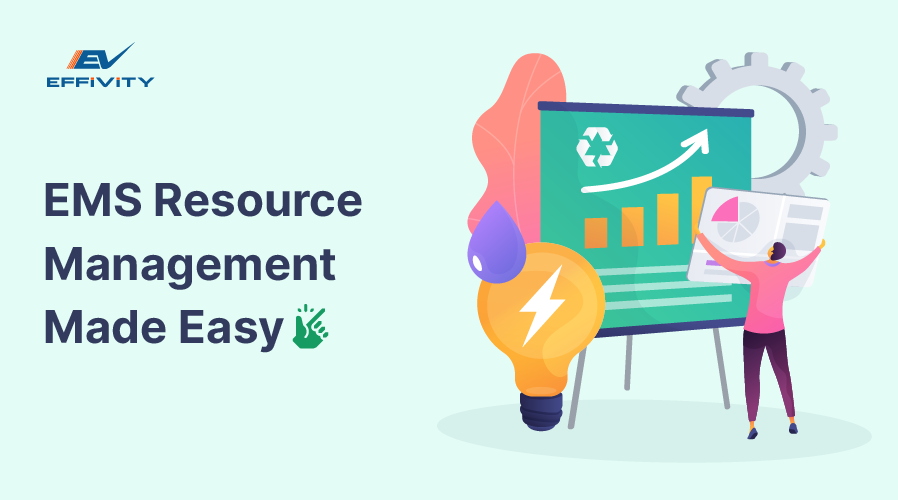The environmental management system is a process of managing a company’s environmental impact. It offers organisations a systematic approach through EMS software for planning, management and implementation of procedures to protect the environment, as per the guidelines of ISO 14001 standard.
ISO 14001 is an international standard that offers a comprehensive framework for organisations to design and implement a robust EMS to help them continually improve their environmental performance.
Within ISO 14001, EMS resource management is critical for minimising environmental footprint and improving operating efficiencies. In this article, we’ll walk you through the meaning and importance of resource management in EMS to drive sustainable growth.
The Importance of ISO 14001
In a time when environmental challenges such as climate change, resource depletion and increasing pollution threaten life, organisations worldwide have a responsibility to minimise their environmental impact .
As a result, implementing an EMS per ISO 14001 regulations allows them to reduce their environmental footprint proactively.
Compliance with ISO 14001 standards allows organisations to

- Demonstrate commitment towards a better environment
- Improve relationships with customers by following eco-friendly practices
- Foster stakeholder trust
- Save costs and reduce wastage
- Boost credibility and public image
Focusing on ISO 14001 requirements can help organisations dedicate themselves to a sustainable future and achieve growth while following their environmental responsibility.
Resource Management
Your environmental management system cannot succeed if you do not have adequate resources to carry out the related processes. Meeting and implementing the initial resource requirements isn’t enough. You must still maintain and improve the EMS to make the system more effective. Again, this depends on the availability of correct resources and critical resource management.
Organisations often don’t struggle with implementing an EMS, but maintaining and improving these activities can be challenging. This happens because the organisation has not allocated adequate resources to these activities. If you identify the resources required on an ongoing basis, you can continue succeeding long after the initial enthusiasm for the new system is over.
ISO 14001 Clause 4.4.1- Roles, Resources, Authority and Responsibility
Within ISO 14001, the EMS resource management requirements are specified in two sub-sections within clause 4.4.1.
Clause 4.4.1 of the ISO 14001 standard describes the requirements for roles, resources, responsibility and authority in terms of environmental management systems.
As per the environmental management requirements, organisations must make available the necessary resources to establish, implement, maintain and enhance the environmental management system.
Simply put, this means that you need to
- Make the resources available promptly to design and set up the system rules (Establish)
- Communicate the rules across the organisation in a way that all the parties are aware of what they are and how they need to be applied (Implement)
- Ensure that the process is continual (Maintain)
- Enhance the system of rules along the way (Improve)
Resources
As per the clause, Resources include human resources and specialised skills, technology, financial resources and organisational infrastructure. In short, anything required to ensure the smooth functioning of EMS is considered a resource. To assess the availability of resources for EMS, as yourself-
- Do you have the right people with the skills needed to implement and maintain EMS?
- Do you have an adequate budget to achieve your EMS and compliance goals?
- Do you have the infrastructural and technical facilities for a successful EMS?
Resource allocation should consider all these to maximise the effectiveness of EMS.
Roles, Responsibilities and Authority
The next section of the clause mentions the roles, responsibilities and authority that you need to define, document and communicate to make EMS effective. This involves assigning responsibility to the top management representative who will oversee that the system is established, implemented and maintained.
In addition, it must be ensured the EMS reports are made available to the top management so that they can review the performance and take necessary steps to ensure improvement. Moreover, the standard only requires that these responsibilities be documented in relation to the environmental management system.
A good way to assign EMS responsibility within an organisation is to be general in your definition of who is responsible for what instead of specifying the name or position of the employee. This is because a change in the personnel or job title will require you to alter all the documents, which can be time-consuming and unnecessary.
ISO 14001 Clause 4.4.2- Competence, Training and Awareness
Clause 4.4.2 of ISO 14001 specifies what you must identify when assigning human resources to the tasks that can impact EMS performance . First, you need to identify and define the competence required to perform an EMS-related task.
Once the competence is defined, you need to identify the employees with the required skills and competence. This competence can be gained through experience, education, or training. So, if a certain employee seems fit for a responsibility but lacks the competency, you must offer them training and education to allow them to carry out their EMS responsibilities effectively.
Finally, when determining environment management requirements for resources, you must also ensure that the organisation is aware of the need for an environmental management system along with the potential environmental impact of the company being controlled and monitored.
In Conclusion
Critical resource management is an important piece of the EMS puzzle. Having the resources you need only helps the company implement an effective EMS and reduce its environmental impact.
This will not only benefit the business with increased customer trust but will also allow them to improve operational efficiency, enhance resource allocation and maintain compliance.






























